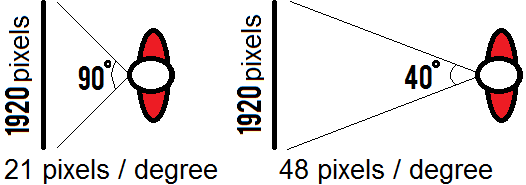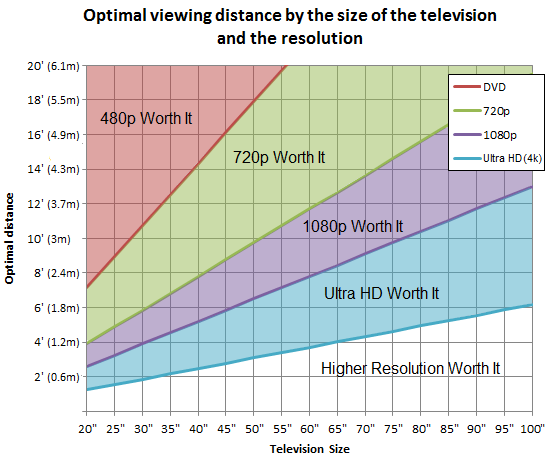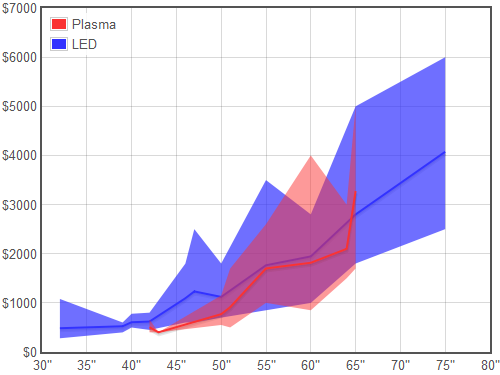The science behind our TV size and distance calculator
Bigger and closer is usually better when it comes to choosing the perfect television for your room. Not only it is the biggest factor affecting the price of a television, but it also has a huge impact on the perceived picture quality.
Angular resolution

If you sit too close though, you will notice the pixels of the television even if you are watching a 1080p HD movie. If you increase your distance from the TV, the density of the details will also increase, producing a better image. This is the angular resolution: the amount of pixel per angle. The farther away, the higher the angular resolution will be.
The limit that you can increase the angular resolution by stepping back depends on your visual acuity. At some point, your eyes are not good enough to distinguish all the details. Studies show that someone with a perfect 20/20 vision (or 6/6 in Europe) can distinguish something 1/60 of a degree apart. This means 60 pixels per degree, or 32.86 degrees for a 1080p television.

Using this data, the closest you can be to your television while still having the maximum perceived angular resolution is about 1.6 times the diagonal measurement of your television. For example, a 55″ television will have an ideal viewing distance of 88″ (55″ x 1.6), or 7 feet and 4 inches. The following table gives you the minimal distance for watching a 1080p HDTV screen while keeping the angular resolution to the maximum that the human can perceive. The chart shows the optimal distance for the DVD (NTSC 720×480 or PAL 720×576), 720p, 1080p and Ultra HD (previously known as 4K) resolutions. Only the horizontal resolution is considered, which is why both NTSC and PAL DVD resolutions are on the same line.
| Screen Size | Optimal Distance 1080p |
| 25″ | 3.3′ (1 m) |
| 30″ | 4′ (1.22 m) |
| 35″ | 4.6′ (1.40 m) |
| 40″ | 5.3′ (1.62 m) |
| 45″ | 6′ (1.83 m) |
| 50″ | 6.6′ (2.01 m) |
| 55″ | 7.3′ (2.23 m) |
| 60″ | 8′ (2.44 m) |
| 65″ | 8.6′ (2.62 m) |
| 70″ | 9.3′ (2.83 m) |
How do you interpret the chart?
There are a few ways to read the chart. For example, let say that you have a 50″ television. Start at the bottom of the chart at 50″. Up to 3′, you are below the blue line. This means you can see the pixels of an Ultra HD resolution. If you go back a bit (up in the chart), between 3′ and 7′ is where an Ultra HD resolution does not matter because you cannot see its pixel anyway. However, you are still too close for a 1080p resolution (it will not appear perfect). Above 7′, the perceived quality will start to decrease for 1080p because your eye will not see all the details. You would notice the difference though it if is 720p. For more than 10′, it does not matter if it is a 720p or 1080p HDTV, your eye is not good enough to see the difference. You will still see the difference for a standard resolution though, up to a 18′ distance. To summarize, you can see the pixels if you are below the line but not above.
Ideally, you want to be exactly on the line for your TV size and media resolution.

This takes into account a perfect resolution, which is never the case in real life. Even if you are watching an HD channel with a high resolution, there will be some artifacts due to the compression algorithm. Artifacts can appear in multiple forms like noise, blurs or a pixelated image (see the picture to the right). You will be able to see artifacts from farther away, so consider the above numbers as being for a perfect 1080p media. The numbers show the minimal distance where you start losing the advantage of the resolution.
Budget
You are probably now thinking something like “My couch is 10′ away from my TV, which according to the chart I need a 75 inch TV. This is insane!”. Yes, if you want to take advantage of the full 1080p resolution this is the ideal size. This brings us to actual limitation of common people: the budget.
The price of a TV is exponential to its size, as shown in the chart. The chart shows the price range of all 2013 TVs by their size.
Source : rtings

